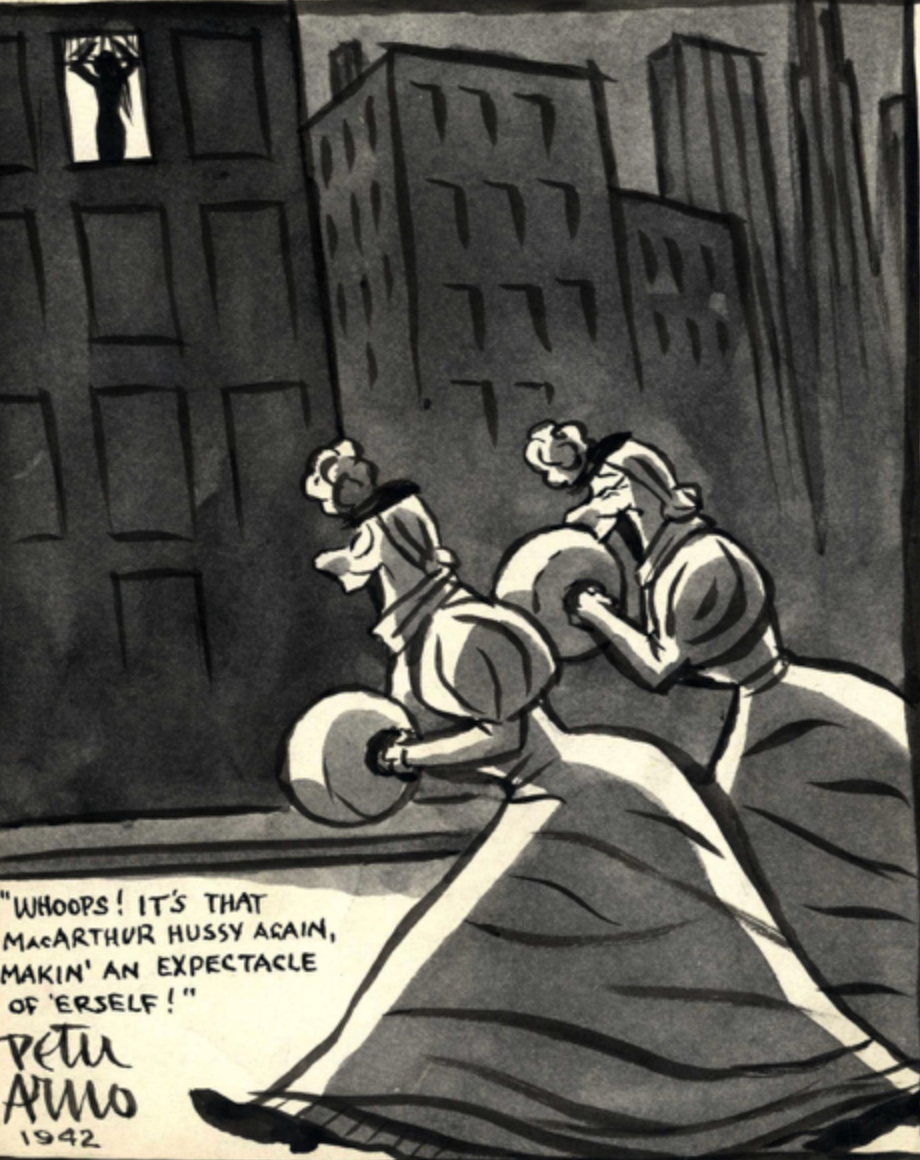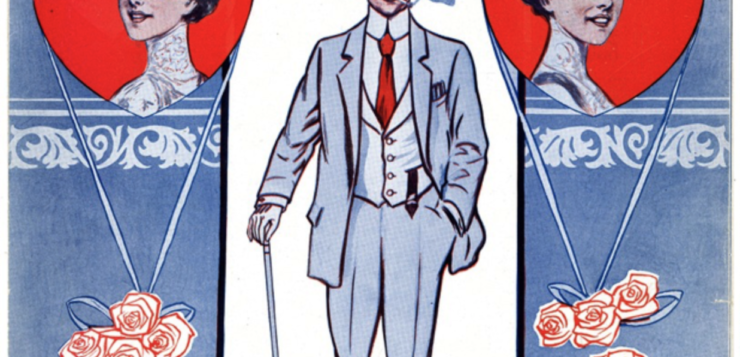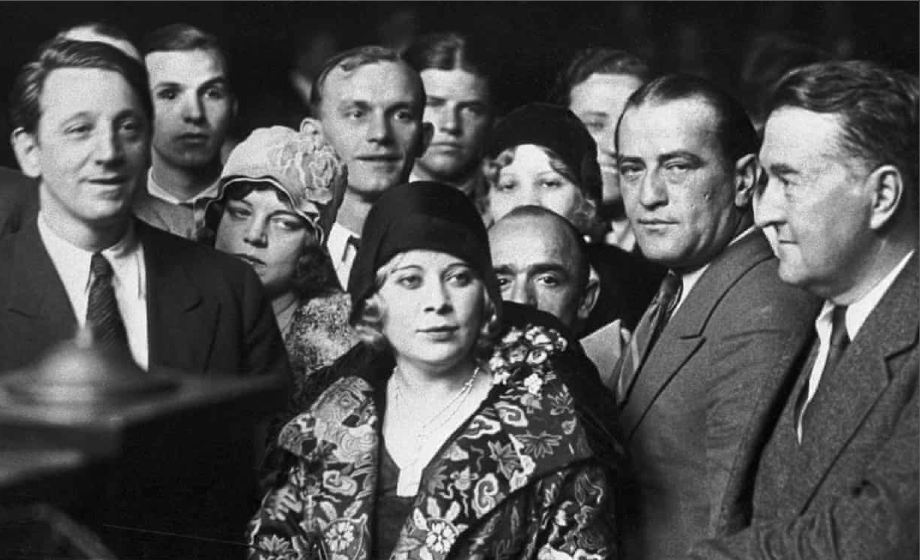IN 2009, the English author Susannah Marriott published a children’s pop-up book called A Field Guide to Fairies. Ms. Marriott was offering a mock natural history of a race of folkloric creatures, but the ambiguous title suggested a potential field guide for the kind of fairy studied by George Chauncey and other historians of same-sex behavior. If the fairy under consideration is taken to mean an effeminate American male of the late 19th or early 20th century, he may be identified by a number of distinguishing traits.
Sartorial signs would be foremost: a red necktie (as seen in the paintings of Paul Cadmus), a jacket with a cinched-in waist, trouser cuffs, patent-leather or suede shoes, a pencil moustache (said to enhance fellatio), and a diminutive cane. His gait would be mincing, his wrist limp and adorned with a slave bracelet, his voice high-pitched, his pronunciation sibilant, his name Percy or Algie. And his mating call would be “Whoops, m’dear!”

According to the Oxford English Dictionary, “whoops,” with its variant “Whoopsie Daisy!” is the exclamation uttered when a harmless accident occurs. The earliest citation it provides is a 1925 New Yorker caption to a Peter Arno cartoon. Arno’s first collection, Whoops, Dearie, came out two years later, when he created the Whoops Sisters. As described by the revue impresario Leonard Sillman, they were “short, squat, look-alike sisters with huge snub noses and puffy cheeks and the eyes of sad seals. They always dressed in black.” These late Victorian ladies, Pansy Smiff and Mrs Abagail Flusser, antiquated in their muffs and leg-o’-mutton sleeves, would engage in cheeky and inappropriate behavior (Figure 1).
The Whoops sisters with their double entendres were variants of the music hall’s “dame comics.” In a rowboat on Central Park Lake, they banter in cockney-inflected backchat:
“Gor! Pipe the sailors! Comin’ right towards us, too.”
“Now you mind yerself, Pansy! Don’t ’ave no truck wit sailors!”
“Lordy! Is that a way t’ talk about yer nation’s defenders? Ain’t yuh got no patriotism?”
This could be the drag comedian Mrs Shufflewick (Rex Jameson) in a gay pub in 1970s London slinging innuendo about her night out.
In a more explicit context, however, the phrase “whoops, my dear” precedes Arno’s sororal duo. Although it does not appear in Eric Partridge’s authoritative Dictionary of Slang and Unconventional English, one source quotes a definition in A Vocabulary of Criminal Slang, With Some Examples of Common Usages (1914) as a “jovial expression of fairies and theatrical characters.” Bruce Rodgers in The Queen’s Vernacular (1972), marking the phrase as dated, defines it as “said when one recognizes another homosexual.” In other words, for much of its career, “Whoops, my dear” was not so much a “homophobic slur” (as one commentator calls it) as an affectionate tribal greeting.

The performing arts have always been a safe haven for unorthodox sexuality, so the overlap between backstage jargon and gay slang is considerable. “Drag,” “slap” (for makeup), and “camp” were first used in a theatrical context, and the British-Romany sub-dialect “Polari” was employed as a private argot by both theater people and “screaming queens.” The dressing-room habit of one man calling another “my dear” had become in England a Masonic handshake of one queer signaling to another. So it was through performance that “Whoops, m’dear” entered common parlance (Figure 2).
The first print example I’ve found is the title of a popular song of 1910, “To arms! To arms! There’s a ring round the moon; whoops my dear,” by Theodore F. Morse, whose lyrics I have not seen. The following year, it shows up in a so-called “coon song” called “Banjo Joe,” but only as an interjection expressing high spirits. Far more explicit and mildly pejorative is another ditty of 1910, “Whoops! My Dear,” by Billy J. Morrissey and Bert F. Grant. The verses and chorus go:
George was a dainty youth well known for miles around,
Upon the street both night and day he always could be found,
With his natty little cane and a flaming crimson tie
When he’d come striding down the line, you’d hear him
loudly cry.
Whoops! My dear. Whoops my dear!
He would yell right on the street
To any girl that he would meet
If by chance he saw a peach
For her arm he’d quickly reach.
Then you’d hear him loudly screech,
“Whoops my dear!”
At the shows he spends his nights, down in a front row seat
He loves to watch the girls in tights, their figures trim and neat.
A handsome youth came out and tried a Spanish dance to do,
When Georgie stood right up and cried, Oh, what I know
of you!
The songwriters are either confused or cagey about the object of their mockery. George has all the external signs of the fairy, yet ogles the girls. Perhaps he is meant to be bisexual avant la lettre (Figure 3).

The catchphrase seems to have caught on around this time, for when Bessie McCoy performed in The Follies of 1911, a large balloon behind her read “Woops [sic]my dear.” More to the point is its appearance in Sewell Ford’s 1912 slang novel Trying Out Torchy (Torchy is a street-smart New York office boy):
“Whoops, m’dear,” says I.
“Eh!” says Bertie.
“Ah, don’t you know the answer to that?” says I. “Say, ‘I’m a daffodil.’ All of which means, Mr. Billings, that you’re to chirk up.”
“I—I don’t in the least understand,” says Bertie.
“All right; deep coises, then,” says I; “but be sure and sound the K soft, as in scissors, and when you cross Madison Square don’t get lost in the woods.”
The passage is less obscure than it may seem. “Daffodil” is a floral synonym for fairy, like “pansy” or “green carnation.” “Chirk up” is slang for cheer up, and “coises” is the Bowery pronunciation of “curses.” The reference to sibilance is obvious, while Madison Square was a queer hangout before and after World War I. The social climber Bertie Billings is being facetiously advised to court popularity with high society by acting like a fairy. (The novel also includes a maidenly male stenographer who yearns to be a cowboy.)
With America’s entry into World War I, another Tin Pan Alley number, “What Do We Care for Kaiser Bill?” (1917), introduced a new type, the sissy fighter pilot:
Now Percy left his home one day to join the flying corps
He said I’ll make those horrid boys and girls feel very sore
The first time that they took him up, it made him feel so queer
When in the clouds they looped the loop, he yelled out
“Whoops, my dear.”
In H. C. Witwer’s From Baseball to Boches (1918), a fictionalized account of a private in the AEF (American Expeditionary Forces), the hero begins a letter to his buddy about visiting “Gay Paris”: “Dear Joe: Whoops, my dear.” After the war, a well-known song asked how returning doughboys could be kept down on the farm after they’d seen Paree. By 1925, however, it was suggested in “I Wish’t I Was in Peoria,” by Billy Rose and Mort Dixon, that small towns were themselves infected with big city decadence:
They’re yelling “Whoops my dear” in Peoria tonight.
They’ve got a big red-blooded warrior,
He wears a red tie in Peoria,
Oh, how I wish’t I was in Peoria tonight.
The “Roaring Twenties” was the heyday of the “nance” performer in vaudeville, burlesque, and nightclubs, which disseminated “Whoops m’dear” as a popular catchphrase. “Transformer,” a typical burlesque-comic act of the time, takes place in a doctor’s office. Here’s how the patient (“Nance”) explains his ailment: “Well, Doctor, I seem to be so girlish. I want to be a big he-man. Every time I pass a pool room all the boys holler whoops, and for what, I don’t know. I could scratch their eyes out. And if I were manly I could do it.” Similarly, in Jack Donahue’s epistolary novel Letters of a Hoofer to His Ma (1931), a straight dancer in variety writes home: “I burnt the tip of my tongue pretty bad and I lisp a little now when I talk. A couple of guys in the first row kept yelling ‘Whoops!’ at me through my act.” The next year the disreputable Green Street Theater in San Francisco, notorious for its racy offerings, was playing “the continental spicy musical cocktail Whoops, My Dear.”
So far, so harmless. Things get more explicit in a refrain, heard in Greenwich Village hangouts and at the lesbian Ballyhoo Club in west Chicago:
In Fairy Town, in Fairy Town,
They don’t go up, they all go down.
Whoops my dear, whoops my dear,
Even the chief of police is queer.
When the sailors come to town, lots of brown,
Holy by Jesus, everybody’s got paresis in Fairytown.
“Go down” implies oral, “brown” is anal intercourse, and paresis is the final stage of syphilis (dementia). This ditty was evidently well known outside of the gay ghettos. The movie stars Barbara Bennett and Louise Brooks could be heard singing it at the Denishawn Dancing School in Los Angeles in 1923. In John Steinbeck’s novel of labor unrest In Dubious Battle (1936), striking fruit pickers howl the “chief of police” line at a traffic cop.
Few people managed to see Mae West’s comedy-melodrama The Drag (1927), as it ran for only two weeks before the police closed it down, but her dialogue gives the phrase a considerable airing (Figure 4). It is the repeated tagline of the drag queen Winnie. Typical is this bit from Act Two:
Clem: How about a little drink?
Duchess: I don’t mind a little drink once in a while.
Clem: Why you big Swede. You’d take it through a funnel if anybody would give it to you.
Winnie: Funnel? That’s nothing. I take it through a hose. Whoops.
A stage direction refers to this as his “usual scream,” which he repeats after any wisecrack or startling development.
Hollywood was not slow to exploit this familiar code. As early as 1913, The Motion Picture Story Magazine titled an article “Whoops, m’dear! Pardonnez moi, s’il vous plait”—the verbal equivalent of a raised pinky. In Frank Capra’s silent comedy The Matinee Idol (1928), a sissy ham actor from the sticks is rehearsing on a Broadway stage. A rough stagehand hisses at him with the intertitle “Whoops, dearie!” The sissy, played by Russian-born David Mir, stands on his dignity.
When sound came in, so did the interjection, as counterpoint to brawny virility. A Fleischer Studio cartoon of 1931, “The Herring Murder Case,” puts it in the mouth of a gorilla named Gus. Tough Pat O’Brien plays a telephone repairman in I’ve Got Your Number (1934). When his work mate says “I’m a man’s man!,” O’Brien flaps his hand onto his chest, and in a falsetto cries out “Ah—Whooooo!”—to the laughter of the other men in the office.
Like so much American slang, “Whoops” enjoyed international fame. Bruce Reynolds’ Paris with the Lid Off (1927) advised tourists who wished to observe “fairy-nice boys” to go to Montmartre’s La Petite Chaumière, where “men of a certain degenerate tendency … dressed as women … cavort around and swish their skirts and sing in falsetto and shout ‘Whoops, my dear.’” Further testimony comes from the diary of Carter “Jeb” Bealer. Traveling to the Isle of Capri with his lover “Dash” Perkins in August 1938, he writes: “When the steamer returned us to port, a jolly Italian sailor leaning over the rail waved to us, although we had never spoken a word to each other. ‘Whoopeee-ta-ta!’ he shouted.” (Compare the line in Noël Coward’s song “Bar on the Piccolo Marina”: “Some sailors said ‘Whoops-a-daisy’ which came as quite a surprise.”)
By the 1930s, the daily press was using “Whoops” as shorthand for the love that dare not speak its name, sometimes to avoid libel suits. Broadway Brevities asked in 1932: “Do Chamberlain Brown, Edwin Franko Goldman and Jean Malin wear ‘whoops-my-dear’ pajamas?” (Brown was a producer of such shows as A Lady for a Night and The Great Necker, Goldman a hetero band leader in Central Park, and Jean Malin a celebrated “pansy” comedian in nightclubs.) That same year, a report of a Harlem drag ball headlined “Men Step Out in Gorgeous Finery of Other Sex to Vie for Beauty Prizes” described it as a “gorgeous thrilling spectacle—a veritable glimpse of fairyland. Whoops!” When the Philadelphia Ballet came to London in 1937, an English newspaper announced “Whoops, M’Dear: Football Players and Boxers Comprise a Ballet Company that Expects to Startle England.”
The anti-fairy militancy of the Gay Liberation Movement may have finally erased “Whoops” from the queer lexicon. As it dropped out of gay speech, it lingered as a hoary slight flung by outsiders. In that regard, the usage has been remarkably long-lived. It is the punchline of a sketch in the British revue Beyond the Fringe (1961) and appears on the movie-house poster of Richard Burton and Rex Harrison kicking up their heels in Staircase (1969). It becomes a coy euphemism for “fairy,” as in the film Peter’s Friends (1992), when Stephen Fry says: “Well, I never disguised the fact that I’m a bit of a whoopsy.”
One of its last widely seen appearances occurs in a television commercial for Heineken beer in 1997. Two young admen are sitting in a bar on Halstead Street, Chicago, which, to those in the know, means Boystown (West Halstead had been the location of the aforementioned Ballyhoo Club). As Bronski Beat plays in the background and they become hemmed in by lads in leather, they slowly realize that there are no women around. “Who told you about this place?” asks one of the men. It was an office-mate named Frank, but not the right Frank. The final letters on the screen are “Whoops.”
Laurence Senelick is the author of The Changing Room: Sex, Drag and Theatre, and editor-translator of Lovesick: Modernist Plays of Same-sex Love.








